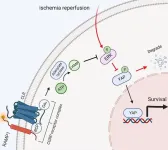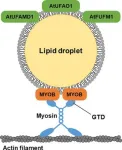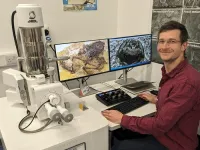(Press-News.org) (Boston)—Mycobacterium tuberculosis, the bacteria that causes tuberculosis (TB), is distinct from most germs in its capacity to silently infect individuals for months and even years before waking up and causing active disease that can lead to severe illness and death. The immune system plays an important role in controlling the germ and keeping it dormant.
Decades of epidemiological data have linked undernutrition to TB. While undernourished individuals have blunted immune systems, a phenomenon which has been dubbed nutritionally acquired immune deficiency (N-AIDS), it is not clear why undernourished individuals are at increased risk of TB disease.
In a new study that followed household contacts (family members/people who share the same dwelling) of persons with TB, researchers have found that undernourished household contacts were three times more likely to progress to TB disease. The study did not find that undernourished contacts were at increased risk of testing positive for TB infection as compared to well-nourished individuals.
“Are they more likely to become infected with the TB germ? Or are their immune systems unable to contain the germ resulting in severe disease? This fundamental question is important to answer as it can guide how we can best protect undernourished individuals who form a key and vulnerable population in the fight against TB,” explained corresponding author Pranay Sinha, MD, assistant professor of medicine at Boston University Chobanian & Avedisian School of Medicine.
The researchers, which included investigators from both U.S. and Indian institutions (which are part of the Regional Prospective Observational Research for Tuberculosis (RePORT) India consortium), identified nearly 900 household contacts of persons who were newly diagnosed with TB, screening them to make sure they did not have TB disease at enrollment. They then followed these contacts to see if they developed TB disease for up to four years. Those who had a negative TB infection test at enrollment were retested to see if it had turned positive. The researchers then compared the rate of TB disease and TB infection between undernourished household contacts and well-nourished household contacts.
According to the researchers, these findings have clinical implications. “We now have greater insight into the mechanism by which undernutrition leads to greater TB risk. It is not by increasing infection, instead, it is by failing to contain the infection when it happens. Fortunately, undernutrition is a modifiable risk factor. Our findings should prompt TB programs to promptly provide adequate rations for the entire household to prevent TB disease among household contacts in addition to TB preventive therapy,” adds Sinha.
These findings appear online in the journal Clinical Infectious Diseases.
This project was funded in whole or in part with federal funds from the government of India’s DBT, the ICMR, the NIH, National Institute of Allergy and Infectious Diseases (NIAID), Office of AIDS Research and distributed in part by CRDF Global. In addition, the following funding sources have supported this work: P. S. is supported by NIAID (award K01AI167733-01A1) as well as funds distributed via CRDF Global (award DAA3-19-65673-1), the Warren Alpert Foundation (6005415), the Burrough’s Wellcome Fund/American Society of Tropical Medicine and Hygiene fellowship, and a career investment award from the Department of Medicine at Boston University Chobanian & Avedisian School of Medicine; A. G., N. G., V. M., M.P. and A. N. G. are supported by NIAID via CRDF Global (awards DAA3-19-65671-1 and DAA3-18-64774-1) and by NIAID (award R01A1I097494); A. N. G. is supported by NIAID (award K99AI151094); and V. V. and H. K. are supported by the Indian DBT (grant USB1-31149-XX-13). A. G. also reports support for this work in the form of funding paid to institution from NIH, Unitaid, and the Centers for Disease Control and Prevention, outside the submitted work. S. G. and V. M. report support for this work in the form of NIH funding for Johns Hopkins Baltimore–Washington–India Clinical Trials Unit from NIAID Networks and CRDF Global, payment to institution.
END
Undernourished household members at increased risk for developing TB after exposure
First study to compare TB infection and TB disease progression rates in a prospective manner
2024-04-23
ELSE PRESS RELEASES FROM THIS DATE:
A non-equivalent co-doped strategy to effectively improve the electrical properties of BIT-based high-temperature piezoelectric ceramics
2024-04-23
In the field of aerospace, a high-temperature piezoelectric vibration sensor is one of the few key devices that can be monitored in a high-temperature and harsh environment, so it is particularly urgent to develop high performance high-temperature piezoelectric ceramics as the core component of this kind of sensor. Bi4Ti3O12 (BIT), as one vital type of bismuth layered structure ferroelectrics (BLSFs), has great application prospects in high-temperature environments due to its excellent TC of 675 ℃. However, the volatilization of Bi during the sintering process in BIT-based ceramics leads to the generation of oxygen vacancy ...
RAMP1 protects hepatocytes against ischemia-reperfusion injury by inhibiting the ERK/YAP pathway
2024-04-23
Background and Aims
Hepatic ischemia-reperfusion injury (HIRI) is a prevalent complication of liver transplantation, partial hepatectomy, and severe infection, necessitating the development of more effective clinical strategies. Receptor activity–modifying protein 1 (RAMP1), a member of the G protein–coupled receptor adapter family, has been implicated in numerous physiological and pathological processes. The study aimed to investigate the pathogenesis of RAMP1 in HIRI.
Methods
We established a 70% liver ischemia-reperfusion model in RAMP1 knockout (KO) and wild-type mice. Liver and ...
Molecular mechanism of chemical diversity of thermophilic fungus and its ecological and biological functions
2024-04-23
Thermophilic fungi are chief components of mycoflora in a variety of natural and manmade composting systems, including rotting hay, stored grains, wood mulch, nesting material of birds and animals, municipal refuse, and self-heating accumulated organic matter. Thermophilic fungi are also a potential source of natural products, which complement the metabolite libraries of mesophilic fungi and bacteria.
The research team led by Prof. Dr. Xuemei Niu (State Key Laboratory for Conservation and Utilization of Bio-Resources in Yunnan, Yunnan University) has been working on the discovery of secondary metabolites in thermophilic fungi and their biological ...
Engaging pharmacists to improve atrial fibrillation care
2024-04-23
DALLAS, April 23, 2024 — Atrial fibrillation, or AFib, is the most common type of irregular heartbeat, estimated to affect about 12.1 million U.S. adults by 2030.[1] The abnormal firing of electrical impulses causes part of the heart to quiver, or fibrillate, often leading to complications and up to a fivefold increased risk of stroke. To help ensure all patients with AFib receive the most appropriate care, the American Heart Association is launching a new effort to educate and engage pharmacists, an important but underrepresented voice in AFib care.
This ...
Exploring brain synchronization patterns during social interactions
2024-04-23
We experience the world and connect with others through social interactions. Engaging in activities, such as conversations, cooperative tasks, and intimate relationships, deeply affect brain activity leading to coordinated neural activity within an individual's brain (intra-brain synchronization) and between the brains of multiple individuals (inter-brain synchronization).
Researchers study brain synchronizations to understand the neural processes behind social behaviors. This knowledge can help diagnose and treat conditions like social anxiety and communication-related disorders. However, investigations on brain synchronization ...
Unveiling the molecular functions of lipid droplet proteins in Arabidopsis thaliana leaves
2024-04-23
Lipids are biomolecules essential for the proper functioning of the living cell, ranging from comprising cell membranes to forming integral components of cell signaling pathways. Plant cells possess cell subcellular structures or organelles called lipid droplets (LDs) in the leaves and seeds, which store excess lipids (fats).
Recent studies have shown that LDs also localize unique plant proteins that perform essential molecular functions. For example, seed LDs localize plant proteins called oleosins, which help seeds weather freezing temperatures and germinate properly. With an expanding body of proof ...
Perfecting the view on a crystal’s imperfection
2024-04-23
NEW YORK, April 23, 2024 — Single-photon emitters (SPEs) are akin to microscopic lightbulbs that emit only one photon (a quantum of light) at a time. These tiny structures hold immense importance for the development of quantum technology, particularly in applications such as secure communications and high-resolution imaging. However, many materials that contain SPEs are impractical for use in mass manufacturing due to their high cost and the difficulty of integrating them into complex devices.
In 2015, scientists discovered SPEs within a material called hexagonal boron nitride (hBN). Since then, hBN has gained widespread attention and ...
Fossil frogs share their skincare secrets
2024-04-23
Palaeontologists at University College Cork (UCC), Ireland, have solved a hundred-year-old mystery of how some fossil frogs preserve their fleshy parts – it’s all down to their skin.
Palaeontologists Daniel Falk and Prof. Maria McNamara, together with scientists from Ireland, Germany and the UK, studied 45-million-year-old fossil frogs from the Geiseltal site in central Germany. Remarkably, the fossils show full body outlines of the soft tissues. The team discovered that the excellent condition of the fossil frogs is due to preservation of ancient skin remnants.
The team studied the fossils with high-precision ...
Existing drugs studied in patients with rare immune diseases
2024-04-23
Existing drugs studied in patients with rare immune diseases
This month the first study within the DRIMID consortium (DRIMID stands for Drug Rediscovery for Rare Immune Mediated Inflammatory Diseases) has started. This study will investigate the efficacy and safety of the drug filgotinib (approved for treatment of rheumatoid arthritis and ulcerative colitis) in three rare immune diseases (Behçet's disease, idiopathic inflammatory myositis, IgG4-related disease). DRIMID aims to investigate whether this drug - despite the absence of formal ...
Loma Linda University study reveals alarming rates of pediatric injuries from mechanical bull riding
2024-04-23
A new study conducted by researchers at Loma Linda University Children’s Health has shed light on the alarming rates of pediatric injuries resulting from mechanical bull riding. The study, titled "Mechanical Bull Injuries in Pediatric Patients: A Call for Safety Regulations," highlights the urgent need for enhanced safety measures and regulations.
The findings were published in the journal Children's Health Care and revealed that mechanical bull riding poses a significant risk to children, with traumatic brain injuries being the most common outcome.
“Mechanical bulls, even when ...
LAST 30 PRESS RELEASES:
Study: Teens use cellphones for an hour a day at school
After more than two years of war, Palestinian children are hungry, denied education and “like the living dead”
The untold story of life with Prader-Willi syndrome - according to the siblings who live it
How the parasite that ‘gave up sex’ found more hosts – and why its victory won’t last
When is it time to jump? The boiling frog problem of AI use in physics education
Twitter data reveals partisan divide in understanding why pollen season's getting worse
AI is quick but risky for updating old software
Revolutionizing biosecurity: new multi-omics framework to transform invasive species management
From ancient herb to modern medicine: new review unveils the multi-targeted healing potential of Borago officinalis
Building a global scientific community: Biological Diversity Journal announces dual recruitment of Editorial Board and Youth Editorial Board members
Microbes that break down antibiotics help protect ecosystems under drug pollution
Smart biochar that remembers pollutants offers a new way to clean water and recycle biomass
Rice genes matter more than domestication in shaping plant microbiomes
Ticking time bomb: Some farmers report as many as 70 tick encounters over a 6-month period
Turning garden and crop waste into plastics
Scientists discover ‘platypus galaxies’ in the early universe
Seeing thyroid cancer in a new light: when AI meets label-free imaging in the operating room
Neutrophil-to-lymphocyte ratio may aid risk stratification in depressive disorder
2026 Seismological Society of America Annual Meeting
AI-powered ECG analysis offers promising path for early detection of chronic obstructive pulmonary disease, says Mount Sinai researchers
GIMM uncovers flaws in lab-grown heart cells and paves the way for improved treatments
Cracking the evolutionary code of sleep
Medications could help the aging brain cope with surgery, memory impairment
Back pain linked to worse sleep years later in men over 65, according to study
CDC urges ‘shared decision-making’ on some childhood vaccines; many unclear about what that means
New research finds that an ‘equal treatment’ approach to economic opportunity advertising can backfire
Researchers create shape-shifting, self-navigating microparticles
Science army mobilizes to map US soil microbiome
Researchers develop new tools to turn grain crops into biosensors
Do supervised consumption sites bring increased crime? Study suggests that’s a myth
[Press-News.org] Undernourished household members at increased risk for developing TB after exposureFirst study to compare TB infection and TB disease progression rates in a prospective manner






